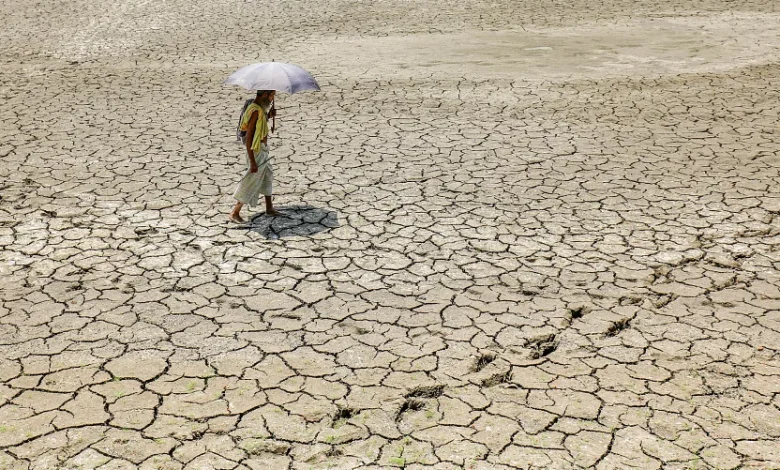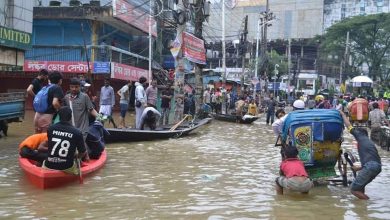Climate change makes heatwave in South Asia including Bangladesh 45 times more likely: Report

The heatwave in Bangladesh and other South Asian countries became 45 times more likely due to climate change, says a new report.
According to a recent finding by the World Weather Attribution (WWA), if the global temperature rises from the current 1.2 degrees Celsius to 2 degrees Celsius, the recurrence of extreme heat incidents is more probable.
These findings are part of the WWA’s report on heatwaves in Asia, which quantifies the effect of human-caused warming on extreme temperatures.
Bangladesh has been facing increasing heatwaves during summer for the last couple of years.
2024 is the hottest year yet, recording average temperatures of 40 to 42 degrees Celsius in all the districts. The population and biodiversity of the country are at stake due to such an unprecedented catastrophe.
Extreme temperatures above 40°C that impacted billions of people across Asia in April were made hotter and more likely by human-caused climate change.
The study highlights how heatwaves intensified by climate change are making life much tougher for people living in poverty across Asia and the 1.7 million displaced Palestinians in Gaza.
The scientists also analyzed historical weather data for a South Asian region including India, Bangladesh, Myanmar, Laos, Vietnam, Thailand, and Cambodia.
In this area, 30-day heatwaves typically occurred once every 30 years. However, due to climate change, they have become 45 times more likely and 0.85°C hotter. This aligns with previous WWA studies, indicating April heatwaves became 1°C hotter and 10-30 times more likely. Additionally, analysis shows similar heatwaves are twice as likely during El Niño conditions.
In South and Southeast Asia, Myanmar, Laos, and Vietnam broke records for their hottest April day, and the Philippines experienced its hottest night ever.
In India, temperatures reached as high as 46ºC. The heat was also extreme in West Asia, with Palestine and Israel experiencing temperatures above 40°C.
The month was the hottest April on record globally and the eleventh consecutive month in a row a hottest month record was broken.
Heat-related deaths were widely reported, with at least 28 in Bangladesh, five in India, and three in Gaza during April. Surges in heat deaths have also been reported in Thailand and the Philippines this year.
These are only preliminary figures, and because heat-related deaths are notoriously underreported, it is likely there were hundreds or possibly thousands of other heat-related deaths in Asia during April.
The heat also led to crop failure, loss of livestock, water shortages, mass die-off of fish, widespread school closures, and low voter turnout in Kerala, India.
“From Gaza to Delhi to Manila, people suffered and died when April temperatures soared in Asia. Heatwaves have always happened. But the additional heat, driven by emissions from oil, gas, and coal, is resulting in death for many people. If humans continue to burn fossil fuels, the climate will continue to warm, and vulnerable people will continue to die,” said Friederike Otto, Senior Lecturer in Climate Science at Grantham Institute – Climate Change and the Environment, Imperial College London.
Climate change, resulting from fossil fuel combustion and deforestation, intensifies global heatwaves, making them more frequent, prolonged, and severe. To assess human-induced warming’s impact on extreme temperatures in Asia, scientists analyzed weather data and climate models, comparing today’s climate (approximately 1.2°C warming) to pre-industrial levels.
Focused on dangerous heat periods in West Asia and the Philippines, researchers examined maximum daily temperatures over three and 15-day averages, respectively. They also evaluated the El Niño-Southern Oscillation’s potential influence.
The study was conducted by 13 researchers as part of the World Weather Attribution group, including scientists from universities and meteorological agencies in Malaysia, Sweden, the Netherlands, and the United Kingdom.
The study highlights how climate change is making life much tougher for people in Asia living in poverty and dealing with the effects of war. In Gaza, many of the 1.7 million displaced people are living in improvised tents that trap heat, have limited access to healthcare and clean drinking water, and lack options to stay cool.
Across South and Southeast Asia, the hundreds of millions of people who live in informal housing and work outdoors, like farmers, construction workers, and street vendors, are disproportionately affected by extreme heat.
“The threat of extreme heat is rapidly increasing across Asia. More than four billion people live on the continent, with heat impacting the most vulnerable groups disproportionately. Heat-related impacts on health are not well-monitored or documented. This really hampers our ability to understand the true impacts and full spectrum of risks associated with extreme heat,” said Carolina Pereira Marghidan, Climate Risk Consultant at the Red Cross Red Crescent Climate Centre, and PhD researcher at the Royal Netherlands Meteorological Institute.
Mariam Zachariah, Researcher at the Grantham Institute – Climate Change and the Environment, Imperial College London, said: “Climate change is bringing more days with potentially deadly temperatures to Asia every year. “This result is unsurprising, but important for highlighting the dangers of extreme heat in Asia. “Unless the world takes massive, unprecedented steps to reduce emissions and keep warming to 1.5°C, extreme heat will lead to even greater suffering in Asia.”





